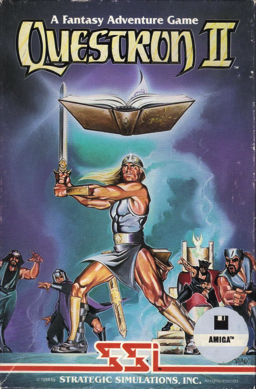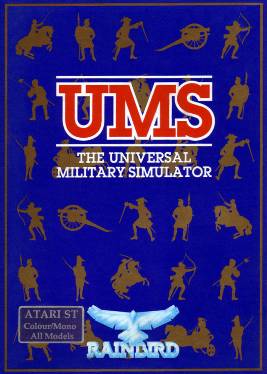
Silent Service is a submarine simulator video game designed by Sid Meier and published by MicroProse for various 8-bit home computers in 1985 and for 16-bit systems like the Amiga in 1987. A Nintendo Entertainment System version developed by Rare was published in 1989 by Konami in Europe and by Konami's Ultra Games subsidiary in North America. Silent Service II was released in 1990. Tommo purchased the rights to this game and published it online through its Retroism brand in 2015.

688 Attack Sub is a submarine simulator video game designed by John W. Ratcliff and Paul Grace and published in 1989 for MS-DOS and in 1990 for Amiga by Electronic Arts. A Sega Genesis version developed by MicroProse was released in 1991 by Sega.

M1 Tank Platoon is a tactical simulator of tank warfare developed and published by MicroProse for the Amiga, Atari ST and MS-DOS in 1989. The game features a mixture of first-person, third-person tank warfare, and tactical simulation gameplay. It was followed by a sequel, M1 Tank Platoon II, released by MicroProse in 1998 for Windows. M1 Tank Platoon was sold to Interplay Entertainment in 2009. M1 Tank Platoon is available on Steam and Epic Games services.

Gunship is a combat flight simulation video game developed and published by MicroProse in 1986. In the game, controlling a simulated AH-64 Apache helicopter, players navigate through missions to attack enemy targets and protect friendly forces. Commercially and critically successful, Gunship was followed by Gunship 2000 and Gunship!.

F-15 Strike Eagle is an F-15 Strike Eagle combat flight simulation game released for Atari 8-bit computers in 1984 by MicroProse then ported to other systems. It is the first in the F-15 Strike Eagle series followed by F-15 Strike Eagle II and F-15 Strike Eagle III. An arcade version of the game was released simply as F-15 Strike Eagle in 1991, which uses higher-end hardware than was available in home systems, including the TMS34010 graphics-oriented CPU.

Bubble Ghost is an action video game created by Christophe Andréani for the Atari ST in 1987. The player controls a ghost who by blowing guides a floating bubble throughout a number of halls in a haunted house, while avoiding obstacles that can make the bubble pop.

Arcticfox is a science fiction tank simulation video game developed by Dynamix and published by Electronic Arts in 1986. It was published in Europe by Ariolasoft. A sequel to Dynamix's Stellar 7, Arcticfox was developed for the Amiga as one of the platform's first titles but was quickly ported to other platforms including the Atari ST, Commodore 64, ZX Spectrum, MS-DOS and Apple II. A third game was released in the series in 1991 titled Nova 9: The Return of Gir Draxon.

GATO is a real-time submarine simulator published in 1984 by Spectrum HoloByte for MS-DOS. It simulates combat operations aboard the Gato-class submarine USS Growler (SS-215) in the Pacific Theater of World War II. GATO was later ported to the Apple IIe, Atari ST, and Mac. In 1987, Atari Corporation published a version on cartridge for the Atari 8-bit computers, to coincide with the launch of the Atari XEGS.

Hostages is a 1988 tactical shooter video game developed and published by Infogrames for the Acorn Electron, Archimedes, Atari ST, Amiga, Apple IIGS, Amstrad CPC, BBC Micro, Commodore 64, MS-DOS, MSX, Nintendo Entertainment System, and ZX Spectrum. The game depicts a terrorist attack and hostage crisis at an embassy in Paris, with the player controlling a six-man GIGN counterterrorist team as they are deployed to defeat the terrorists and free their hostages.

Questron II a 1988 role-playing video game published by Strategic Simulations for the Apple II, Apple IIGS, Atari ST, Commodore 64, IBM PC, and Amiga. It is the sequel to 1984's Questron. The story and original design is credited to Quest Software, the programming and artwork is credited to Westwood Associates.

Macadam Bumper is a video pinball simulation construction set developed by ERE Informatique in France. It was first released for 8-bit computers in 1985, the Atari ST in 1986 and MS-DOS in 1987. The Atari ST and MS-DOS versions were released in the US as Pinball Wizard in 1988 by Accolade.

Skyfox II: The Cygnus Conflict is a space combat computer game developed by Dynamix and published by Electronic Arts in 1987 for the Commodore 64 as a sequel to the original Skyfox for the Apple II. It was ported to the Amiga, Atari ST, and MS-DOS. The creator of Skyfox, Ray Tobey, was not involved in this game.

The Universal Military Simulator is a computer game developed by Rainbird Software in 1987 for the Macintosh, Tandy 4000, and IBM PC compatibles. In 1988, both Atari ST, Amiga versions were released. The game was created by Ezra Sidran. The PC and Amiga versions were ported by Ed Isenberg. The game spawned two sequels: UMS II: Nations at War and The War College: Universal Military Simulator 3.

PT-109 is a naval simulation video game developed by Digital Illusions and Spectrum HoloByte in 1987 for the Macintosh and MS-DOS. This game is roughly based on the events involving the Motor Torpedo Boat PT-109.

Dive Bomber is a video game developed by Acme Animation in 1988 for the Commodore 64. It was ported to Atari ST, Apple II, ZX Spectrum and MS-DOS.

Final Assault, known as Chamonix Challenge in Europe, originally Bivouac in French, is a mountaineering simulation distributed by Infogrames and Epyx in 1987 for the Amiga, Amstrad CPC, Apple IIGS, Atari ST, Commodore 64, MS-DOS, Thomson and ZX Spectrum. The original release of the game was copy protected.

Ogre is a 1986 computer game based on the Ogre board wargame. It was released by Origin Systems for the Apple II, Amiga, Atari 8-bit family, Atari ST, Commodore 64, MS-DOS, and Macintosh.

Submarine Commander is a simulation video game for Atari 8-bit computers written by Dean Lock and published by Thorn EMI Computer Software in 1982. A VIC-20 port by Gary York was released in 1983 and an Apple II version by Patrick Buckland the same year. The Atari version was re-released in 1985 on cassette on the Sparklers budget label. A version for the TI-99/4A was announced but was not released until 1986 when a third party bought the rights.

Mickey Mouse: The Computer Game, also known as just Mickey Mouse, is an action game developed and published by Gremlin Graphics in 1988 for the Amiga, Amstrad CPC, Atari ST, Commodore 64, and ZX Spectrum.

Objective: Kursk is a 1984 computer wargame designed by Gary Grigsby and released by Strategic Simulations, Inc.





















